
About UsThe Numismatic Bibliomania Society is a non-profit organization promoting numismatic literature. For more information please see our web site at coinbooks.org SubscriptionsThose wishing to become new E-Sylum subscribers (or wishing to Unsubscribe) can go to the following web page link MembershipThere is a membership application available on the web site Membership Application To join, print the application and return it with your check to the address printed on the application. Membership is only $15 to addresses in the U.S., $20 for First Class mail, and $25 elsewhere. For those without web access, write to: David M. Sundman, Secretary/TreasurerNumismatic Bibliomania
Society AsylumFor Asylum mailing address changes and other membership questions, contact David at this email address: dsundman@LittletonCoin.com SubmissionsTo submit items for publication in The E-Sylum, just Reply to this message, or write to the Editor at this address: whomren@coinlibrary.com
BUY THE BOOK BEFORE THE COINYou won't regret it! |
- WAYNE'S WORDS: THE E-SYLUM JUNE 23, 2013
- KOLBE-FANNING 129TH MAIL BID SALE CATALOG AVAILABLE
- LAKE BOOKS SALE #115 CATALOG AVAILABLE
- NEW BOOK: FRIEDBERG PAPER MONEY OF THE U.S. 20TH EDITION
- NEW BOOK: STANDARD CATALOG OF WORLD COINS 1901-2000, 41ST ED
- NEW PUBLICATIONS ON 19TH CENTURY MONETARY HISTORY
- BOOK REVIEW: JOHN J. FORD AND THE FRANKLIN HOARD
- MORE ON CASH SAVINGS CHECKS
- NOTES FROM E-SYLUM READERS: JUNE 23, 2013
- THE BOWERS UNIVERSAL RARITY SCALE
- HOWARD BERLIN REMEMBERS DICK DOTY
- GAR TRAVIS RETIRES FROM TELETRADE
- MISSOURI CABINET OF HALF CENTS CATALOG AVAILABLE
- DISCOVERING THE FINEST 1794 HALF CENT, HIGH RELIEF HEAD
- VIRGIL MCKNIGHT HANKS, JR.
- ORMSBY’S 1862 'HARVEST OF COUNTERFEITERS'
- JEFF SHEVLIN JOINS NORTHWEST TERRITORIAL MINT
- DICK JOHNSON ON JEFF SHEVLIN'S APPOINTMENT
- QUERY: HOW DO YOU MAKE AN ELECTROTYPE?
- MORE ON MAP MEDALS
- QUERY: DORR & BREWSTER INFORMATION STILL SOUGHT
- TOKENS OF WILLIAM BATEMAN OF WARRNAMBOOL, AUSTRALIA
- LONDON COUNTERFEITERS PAINTED FAKE LEAD COINS
- THE MUSEUM OF MILETUS, TURKEY
- ON THAT OLD BOOK SMELL
- JOHN J. FORD'S HOTEL HALLWAY PREDICAMENT
- FEATURED WEB PAGE: ANS MAGAZINE
WAYNE'S WORDS: THE E-SYLUM JUNE 23, 2013

New subscribers this week include Josh Illingworth, courtesy of David Lange. We have 1,650 email subscribers, plus 234 followers on Facebook.
This week we open with information about two upcoming numismatic literature sales, five new numismatic publications, and a review of the John Ford/'Franklin Hoard' book.
Other topics include Cash Savings Checks, the Universal Rarity Scale, the catalog of the Tettenhorst collection of US. half cents, Virgil Hanks, former ANA Executive Director Jeff Shevlin, and how to make an electrotype.
To learn more about the Father Kino silver bars, the Bateman tokens of Warrnambool, that Old Book Smell, Venezuelan Beaver Cheese and John Ford's hotel hallway adventure, read on. Have a great week, everyone!
Wayne Homren
Editor, The E-Sylum
KOLBE-FANNING 129TH MAIL BID SALE CATALOG AVAILABLE
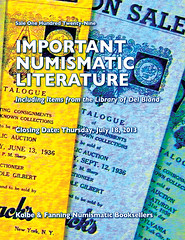 Kolbe & Fanning Numismatic Booksellers have announced their 129th mail-bid sale of important numismatic books, which will close on Thursday, July 18. The sale features selections from the library of renowned U.S. copper specialist Del Bland and other properties, and includes works on ancient, medieval, foreign and U.S. numismatics. It is perhaps most important for significant runs of U.S. auction catalogues.
Kolbe & Fanning Numismatic Booksellers have announced their 129th mail-bid sale of important numismatic books, which will close on Thursday, July 18. The sale features selections from the library of renowned U.S. copper specialist Del Bland and other properties, and includes works on ancient, medieval, foreign and U.S. numismatics. It is perhaps most important for significant runs of U.S. auction catalogues.
The sale is composed of 660 lots of literature covering the entire range of numismatics. Highlights include:
—Del Bland’s remarkably fine complete set of Stack’s catalogues (lot 556)
—The complete Erbstein collection, bound with the rare 1911 Hess sale of Hermitage duplicates (lot 83)
—A complete set of Barney Bluestone catalogues (lot 253)
—A fine set of Fiala’s Katalog der Münzen- und Medaillen-Stempel-Sammlung des K. K. Hauptmünzamtes in Wien (lot 73)
—A rare plated Chapman catalogue of the Simpson collection (lot 354), among many other plated Chapman catalogues including Earle, Jenks, Gable, Sargent and others.
—Mayer’s rare bibliography of Islamic numismatics (lot 132)
—Del Bland’s impressive set of Hesslein catalogues (lot 433)
—Mehl’s Numismatic Monthly, complete (lot 484)
—Charles Elmore Green’s Deluxe, Photographically Illustrated Dunham Catalogue (lot 488)
—Ormsby’s Very Rare 1862 Harvest of Counterfeiters (lot 510).
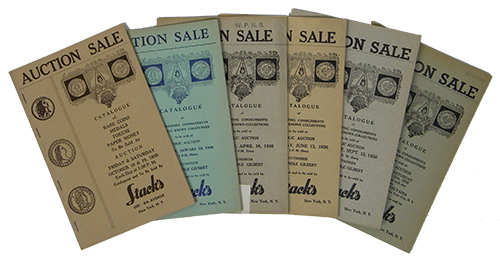
Bids may be placed via mail, email, phone or fax. The printed catalogue has been sent to customers on the Kolbe & Fanning mailing list. A limited number of copies remain available for purchase for $15 postpaid. The catalogue also may be downloaded in PDF form from the Kolbe & Fanning website at www.numislit.com. For full bidding instructions, please see the catalogue and read the terms of sale.
For more information or to place bids, please contact David Fanning at df@numislit.com or (614) 414-0855. Thank you, and we look forward to your participation!
LAKE BOOKS SALE #115 CATALOG AVAILABLE
Lake Books' 115th mail-bid auction is now available for viewing at < www.lakebooks.com/current.html The 481-lot sale features reference material from the libraries of David Wnuck and Joseph Ercolano. One dozen other consignors have added likewise important books and catalogs covering United States Coinage, World Coins, Paper Money, Tokens & Medals, and Miscellaneous Exonumia. The offering has a closing date of July 23, 2013 at 5:00 PM (EDT).
Notable lots include Loubat's plate volume of "Medallic History of the United States", the fine Quarterman reprint of Maris' "Coins of New Jersey", a special presentation copy of "Breen's Encyclopedia of Early United States Cents: 1793 to 1814" edited by Mark Borckardt, a beautifully hardbound copy of Evan Kopald's 2006 "Fixed Price List of United States Cents" plus many more desirable lots to enhance the most discriminating collector's library.
Bids may be placed via email, fax, telephone or US Mail prior to the closing time. Remember that tie bids are won by the earliest bid received.
Good Luck with your bidding, Fred
Lake Books
6822 22nd Ave N
St. Petersburg, FL 33710
727-343-8055 Fax: 727-381-6822
NEW BOOK: FRIEDBERG PAPER MONEY OF THE U.S. 20TH EDITION
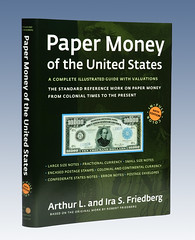 Sixty years after its introduction, the twentieth edition of Paper Money of United States, the standard reference book on United States paper money, is being released by the Coin & Currency Institute. In 1953, the late Robert Friedberg (1912-1963) broke new ground when the Treasury Department granted permission for photographs of American paper money to be printed for the first time. The current edition's 328 pages sets the standard once again by featuring notes from America's greatest currency collections, all reproduced in color.
Sixty years after its introduction, the twentieth edition of Paper Money of United States, the standard reference book on United States paper money, is being released by the Coin & Currency Institute. In 1953, the late Robert Friedberg (1912-1963) broke new ground when the Treasury Department granted permission for photographs of American paper money to be printed for the first time. The current edition's 328 pages sets the standard once again by featuring notes from America's greatest currency collections, all reproduced in color.
The inaugural edition of Paper Money of the United States also introduced other innovations never before attempted. The subject became standardized and the book earned a permanent place on reference shelves. During the past three decades, it has been completely expanded, revised, and edited by Ira S. Friedberg and Arthur L. Friedberg, who has been recognized by the International Association of Professional Numismatists with its highest honor, the title of Honorary President.
As with any price catalog, the twentieth edition of Paper Money of the United States is a snapshot in time – and as the new edition debuts, the paper money market has recovered from its recessionary depths and some notes are once again setting price records. As with every edition, all valuations have been adjusted to reflect market conditions, which are mostly up. The prices are given in up to seven states of preservation from Very Good (VG8) to Gem Uncirculated (Gem65). There are also several other significant additions and revisions to the new volume, making it a necessity for every collector and dealer of American currency.
From the first year of Federal paper money, 1861, to the present, the fronts and backs of all classes and types of currency, from 3 cents to 10,000 dollars are illustrated. These are accompanied by text listing, describing and pricing every variety of paper money ever issued, more than 10,000 prices in all. With close to 1,000 color photographs, the result is a complete pictorial, descriptive and numismatic history of the currency of the United States.
There are supplemental sections on Colonial and Continental Currency (notes issued from 1680 to 1788), the Treasury Notes of the War of 1812, considered by some to be the first national currency, a comprehensive listing by type of the issues of the Confederate States of America, and sections devoted to paper money errors, postage envelopes, and encased postage stamps. The latter two, along with Fractional Currency, were created to alleviate the shortage of change needed for commerce during the Civil War. The listing in the Appendix of the 14,348 National Banks that existed from 1863 to 1929 also shows the numbers of large size and small size notes known to exist for each note-issuing bank.
Paper money collectors depend on the Friedberg Numbering System™, a uniform method of cataloging bank notes that is the international standard for American currency. This numbering shorthand, along with the hundreds of photographs, enables anyone to instantly locate a specific banknote, and allows a dealer to advertise a note without need of extensive description. A distinguished panel of acknowledged experts on paper money has assisted the authors, enabling them to establish accurate and up-to-the minute valuations for all issues.
Paper Money of the United States has been an invaluable asset to currency collectors and numismatists for generations. It possesses an appeal and value of its own, not just to lovers of Americana and of the fine art of engraving, but to students of American history, finance and economics. It is recognized as a landmark work and is the undisputed standard reference on American currency – internationally acknowledged as the most comprehensive and universally quoted guide on the subject. Banks in America and throughout the world will find this book especially useful in that it makes possible the immediate identification of all obsolete but still legal tender paper money, while simultaneously giving the collector’s value of each note. It is a book which belongs in every library, public and private.
Sample pages from the 20th edition may be seen on the book’s website, www.PaperMoneyoftheUS.com.
The book is available in three formats. A low-price, easy to carry soft cover version (ISBN 978-087184-520-7) is $42.50. A long-lasting, hard-bound copy with sewn binding (ISBN 978087184-720-1) is $67.50. An e-book edition (ISBN 978-087184-0202-2) costs $29.50.
The books are available or may be ordered from book stores, coin and paper money dealers, and from internet book sellers. Copies may also be obtained from the Coin & Currency Institute, P.O. Box 399, Williston, Vermont 05495. $5.75 should be added to each order for shipping and handling. Major credit cards are accepted. Call toll-free 1-800-421-1866. Fax (802) 536-4787. E-mail: info@PaperMoneyoftheUS.com. In Europe, contact Spink & Son, Ltd., London.
THE BOOK BAZARRE
NEW BOOK: STANDARD CATALOG OF WORLD COINS 1901-2000, 41ST ED
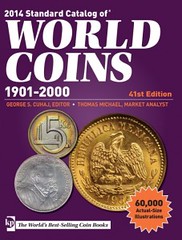 The new edition of the Standard Catalog of World Coins 1901-2000 is now available from Krause Publications. Now in its 41st edition, the Standard Catalog remains the only resource dedicated to world coins from the 20th century.
The new edition of the Standard Catalog of World Coins 1901-2000 is now available from Krause Publications. Now in its 41st edition, the Standard Catalog remains the only resource dedicated to world coins from the 20th century.
Editors Tom Michael and George Cuhaj work with a worldwide network of more than200 experts to provide the latest market values in five grades. In addition to more than 1 million accurate values, the Standard Catalog features 60,000 quality images and hundreds of new and/or improved images for easy identification.
Collector coins, sets, trial strikes, Pieforts, patterns, token issues and more are included in the Standard Catalog.
For more information visit www.sellcoinbooks.com/world-coin-books/2014-standard-catalog-of-world-coins-1901-2000
NEW PUBLICATIONS ON 19TH CENTURY MONETARY HISTORY
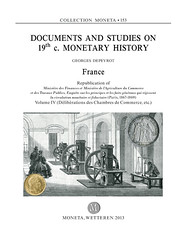 Republication of Ministère des Finances et Ministère de l'Agriculture du Commerce et des Travaux Publics, Enquête sur les principes et les faits généraux qui régissent la circulation monétaire et fiduciaire (Paris, 1867-1869).
Republication of Ministère des Finances et Ministère de l'Agriculture du Commerce et des Travaux Publics, Enquête sur les principes et les faits généraux qui régissent la circulation monétaire et fiduciaire (Paris, 1867-1869).
The last three volumes (see vol. I, Moneta n°133; vol. II, Moneta n°134; vol. III, Moneta n°135);
Moneta n° 153, Volume IV (Délibérations des Chambres de Commerce, etc.), 2013,
IV+1012+4* p. ISBN 978-94-91384-21-9
www.moneta.be/volumes/moneta_153.htm
Moneta n° 154, Volume V (Dépositions écrites françaises et étrangères), 2013,
IV+822+6* p. ISBN 978-94-91384-23-3
www.moneta.be/volumes/moneta_154.htm
Moneta n° 155, Volume VI (Rapport; Délibérations du Conseil Supérieur; Documents annexes), 2013,
IV+742+4* p. ISBN 978-94-91384-23-3
www.moneta.be/volumes/moneta_155.htm
BOOK REVIEW: JOHN J. FORD AND THE FRANKLIN HOARD
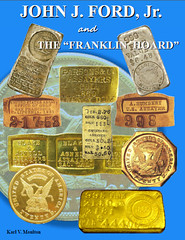 Karl Moulton, “John J. Ford, Jr. and the ‘Franklin Hoard’”
Karl Moulton, “John J. Ford, Jr. and the ‘Franklin Hoard’”
By John Kleeberg
This book provides a double biography of John Ford and Paul Franklin and the forgeries they marketed, but it is oddly arranged, which makes the author’s arguments difficult to follow. It resembles a scrapbook more than a proper book.
The documents are arranged in strict chronological order, with many reproduced attractively in full color. The chronological order reveals some new insights – it appears that the reason so many USAOG prooflike $20s hit the market in such a large quantity in a short period of time in early 1958 (a crucial mistake by the forgers) is because Ford realized that F. C. C. Boyd was sick and dying, and Ford needed the cash so he could lock up the coins and paper money in the F. C. C. Boyd Estate.
The book makes for interesting, but not always enjoyable, reading. The portrait of John Ford that emerges is extraordinarily dark and negative. On page 514 the author even goes so far as to call John Ford a psychopath. Ford once said that upon the creation of NASCA he advised Douglas Ball to go into business with Herb Melnick, saying “He is a wolf, but he will protect you from the other wolves.” While reading this book I couldn’t help but thinking that that must be the explanation why a decent guy like Charlie Wormser would work with John Ford for twenty years.
The author had the co-operation of Gerow Paul Franklin’s family, which may explain the attempts to whitewash Franklin. The author suggests that perhaps Franklin did not make the fake items, they were actually made by someone else – maybe Peter Rosa, maybe Kenyon Painter, maybe Hedgepeth, maybe Diehl – ignoring that of those persons, none, not even Rosa, possessed the sophisticated metalworking skills that Franklin did. Moreover, the provenances of the fake items trace back again and again to Ford and Franklin, and not to anyone else.
The author argues that because Franklin was sentenced to probation and not imprisoned, he had never been convicted of counterfeiting. This is quite simply incorrect. The author is right in his observation that an arrest is not the same as a conviction, but a defendant cannot be sentenced to probation or to anything else without being convicted first.
After Franklin was arrested in July 1943 for draft evasion and firearms offenses, the author tells us that Franklin spent over a year in Lewisburg penitentiary (pages 111-13). That is the type of sentence that is meted out to a defendant who has a prior criminal history, whereas a first-time offender would be offered probation.
Another incorrect interpretation by the author, in my view, is his belief that when Franklin made trips out West he was traveling out to buy the fake bars and coins. I disagree. Franklin made the items back in the East. Franklin’s trips out West were not to buy the manufactured products, but to acquire illicit gold – either from contacts in the mining industry (Franklin was a member of the Arizona Small Mine Owners Association), or by smuggling bullion from Mexico. It is a pity the book was not copy-edited more thoroughly, for there are quite a few misspellings and errors in grammar and syntax.
I can also add some additional details about the origins of the false Mexican gold bars. The author suggests that they were inspired by the fake “Father Kino” bars that were sold as souvenirs throughout the Southwest. This is plausible, but there was a more direct inspiration. Harry Rieseberg wrote books about treasure hunting that were fiction masquerading as fact. He also wrote the script for a 1953 movie (from Universal-International) about treasure hunting, “City Beneath the Sea.”
While going through Gordon Frost’s library I came across a collection of promotional photographs from movies with numismatic content. One of the photographs was for “City Beneath the Sea,” dated 1953, and it shows the Mexican HISP ET ID bars, which are clearly movie props, mere blocks of gold painted wood. The caption reads: “EVER SEEN SUNKEN TREASURE? Here is $28,000 worth, in gold, found during the undersea peregrinations of Lieut. Harry E. Rieseberg, famed treasure hunter, whose experiences on the ocean bed near the sunken city of Port Royale [sic] provide the background for his authorship of Universal-International’s Technicolor adventure, ‘CITY BENEATH THE SEA.’”
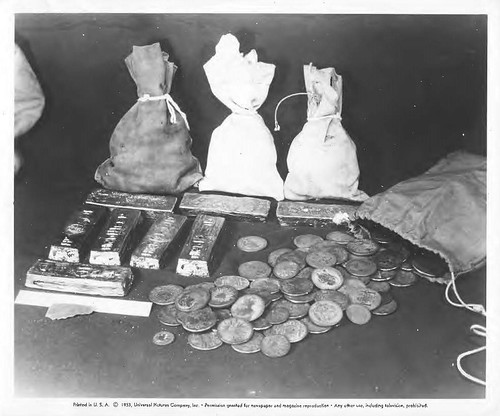
Reproductions of this photograph may be found in Rieseberg’s “Treasure of the Buccaneer Sea” (1962) and in his “Fell’s Guide to Sunken Treasure Ships of the World” (1965). These movie props of 1953 served as the model for the subsequent gold fakes.
The book reproduces correspondence not only from the files of John Ford, but also from Gerow Paul Franklin, Eric P. Newman, and Q. David Bowers, which adds immeasurably to the book’s value. Eric Newman’s notes from his interview with Kenyon Painter are particularly helpful.
Some interesting quotes: From a letter of John J. Pittman to John Ford, November 26, 1958 (page 439):
“One of your ‘friends’ got drunk at one of the conventions and intimated that the dies were still in existence and that the pieces may have been manufactured in the eastern part of the U.S. within the last several years by Paul Franklin for you, and moreover, that you had been bragging that you had taken me for a pigeon with respect to the 1853 U.S. Assay Office $20 proof.”
(Pittman subsequently returned the prooflike USAOG $20 to Ford.)
Note this quote from Ford in Coin World, September 6, 1999 (page 750):
“Ford insists he never had contact with a smelter and questions why a refiner would have risked selling him gold, when it would have meant risking his license to operate at the time.”
Contrast that with what Gerow Paul Franklin writes in a letter of 1962 (page 486):
“On your inquiry regarding the placer gold I have a friend out West from whom I have obtained some nice gold specimens I will write him and inquire as to how much it costs now. I have paid as high as $53.00 an ounce for dust and small nuggets, as high as $75.00 to $80.00 for large nuggets and leaf gold specimens these of course are more rare.”
A further correction: The John J. Ford selling counterfeit money in 1891 (pages 823-824) cannot have been John Ford’s father. John J. Ford, Jr., was born on March 5, 1924, and in the 1930 Federal census his father’s age is given as 40 years old, i.e. John J. Ford, Sr., was born circa 1890.
The book will appeal to the “completist” who wants to collect every single book about territorial gold. The book assembles in a single convenient volume ephemera that can be difficult to track down, even if you already own them (“Now where did I put that photocopy that I was just looking at last week?”).
It is good of the contributors to this volume to share all this data with us, and for the author/editor to have assembled it in such a convenient form. But the greatest appeal of this book is that a few decades ago, none of this information was allowed to be published at all. Ford so intimidated Coin World and Numismatic News that there was no coverage of Ted Buttrey’s exposé of the false Mexican gold bars, which finally appeared in Memorias de la Academia Mexicana de Estudios Numismáticos.
As Ford wrote in a letter of October 3, 1979 (page 666): “This article was published in English, in a Spanish language publication, presumably for clandestine distribution in the United States.” This is quite true – most numismatists had to be content with bootleg photocopies. Only a few lucky persons were trusted enough to be given an original from the source speakeasy (Eric Newman’s basement). To those of us who remember that period, it is amazing that Moulton has been able to publish this book and that we are allowed to read it.
In the 1950s there were false silver bars being sold in souvenir shops in the Southwest. These bars are not very convincing - they bear a cross and the letter V, they are very simple in their designs, they are made from debased silver or maybe tin. They were promoted as having been the products of mining efforts by the Jesuits in the 17th and 18th centuries in New Mexico and Arizona, and attributed to the Jesuit priest Father Kino. These are just wild stories; the Jesuits did a lot of good work on the northern frontier of New Spain, but one thing they did not do was to run mining operations.
Karl Moulton suggests that these bogus bars were the model for the false Mexican gold bars. I do not think this is quite correct, although these bars and the Kino stories may have inspired another false ingot, the Tubac ingot that Buttrey wrote up in the Numismatic Chronicle. There is, to my mind, a more direct inspiration for the false Mexican gold bars.
Meanwhile, Harry Rieseberg was making up his stories about treasure hunting and persuaded Universal to convert them into a motion picture ("City Beneath the Sea"). As part of the promotion, Mexican gold bar props were made out of wooden blocks in 1952-53. Photographs of these bars were circulated by Universal's publicity department, and Rieseberg re-used them in at least two of his books.
Although Rieseberg claimed the bars were gold, if you look closely at the picture it is clear that they are gold painted wooden blocks. They resemble the later false Mexican gold bars with the shield and HISP ET ID except that the letter "S" is reversed and, of course, they are wood, not gold.
On September 1, 1954, as published in The Numismatist, Paul Franklin showed up at the Brooklyn Coin Club and exhibited a gold Mexican HISP ET ID bar (see Moulton page 253). Thereafter the bars were sold/traded by John Ford all over the U.S. numismatic community - to Wayte Raymond, F. C. C. Boyd, Werner Amelingmeier, Mrs. Norweb, Stack's, Josiah K. Lilly, and ultimately the Smithsonian after the government acquired the Lilly collection.
Ted Buttrey condemned these bars as fake at the International Numismatic Congress of 1973 held in New York City and Washington, and his paper was later published in the Mexican journal Memorias de la Academia Mexicana de Estudios Numismaticos. This explains why there are a group of false Mexican bars in Rieseberg's work that are not traceable back to John Ford and Paul Franklin; the wooden blocks painted gold, made to the specifications of Rieseberg and the Universal studio, served as the model that Franklin used to make false Mexican bars out of real gold.
To read an earlier E-Sylum article, see: BOOK REVIEW: JOHN J. FORD AND THE FRANKLIN HOARD (www.coinbooks.org/esylum_v16n24a05.html)

MORE ON CASH SAVINGS CHECKS
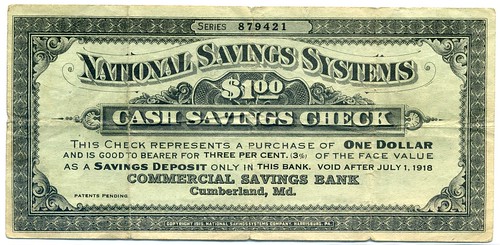
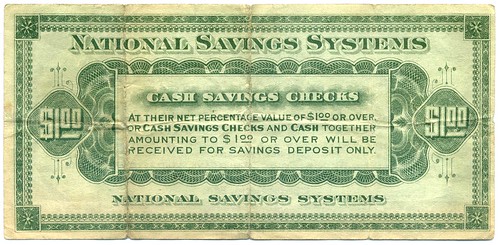
National Savings Systems 1 dollar cash savings check
Last week Eric Schena wrote:
I also brought a pair of somewhat mysterious Maryland scrip items: 50¢ and $1 National Savings Systems "cash savings checks" issued by the Cumberland Savings Bank of Maryland. The notes are copyrighted 1915 by the National Savings Systems Company of Harrisburg, PA and bear interest up to July 1918. I have so far not seen any other items like these, nor have I been able to find any more info on National Savings Systems. I brought them since there were a few Maryland numismatists present, but no one seems to have seen anything like them. Anyone else seen these things before? Did they function like Postal Savings System certificates from roughly the same era?
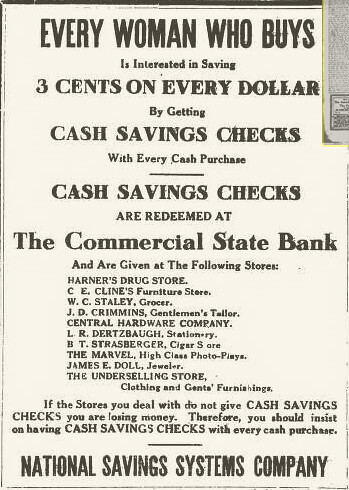
To read the earlier E-Sylum article, see: WAYNE'S NUMISMATIC DIARY: JUNE 16, 2013: (www.coinbooks.org/esylum_v16n25toc.html)
To see the complete page on Newspaper Archive, see: http://newspaperarchive.com/news/1915-10-22/page-8
NOTES FROM E-SYLUM READERS: JUNE 23, 2013
The Mysterious Large Cent Lady Typo
Regarding the headline on last week's article by Harvey Stack on the Mysterious Large Cent Lady,
Rich Hartzog writes:
Either Stack is a lot older than I thought, or there is a century error.
To read the earlier E-Sylum article, see: THE MYSTERIOUS LARGE CENT LADY OF 1854 (www.coinbooks.org/esylum_v16n25a15.html)
ANA Headquarters Spared From Fires
Barbara J. Gregory, Editor-in-Chief of The Numismatist writes:
For many American Numismatic Association employees, the recent Black Forest Fire is, in the words of Yogi Berra, "like deja-vu, all over again," recalling the Waldo Canyon Fire that began last summer on June 23, 2012. However, the Black Forest Fire—which started last Tuesday and is 65% contained as of this morning—is about 18 miles northeast of ANA headquarters (versus 7 miles northwest for the Waldo Canyon Fire.)
As such, headquarters is not threatened, and, thankfully, no employees have been evacuated. Smoke has been minimal in the downtown Colorado Springs area, and showers and cooler weather have aided the firefighters' efforts.
The ANA would like to thank its many members who have called and e-mailed to express their concern. Our thoughts are with the more than 480 families who have lost homes and the many hundreds of firefighters who have worked tirelessly to protect life and property.
To read the earlier E-Sylum article, see: COLORADO SPRINGS FIRES RETURN (www.coinbooks.org/esylum_v16n25a05.html)
The Ancient Coins in Arnhem Land Expedition
Chris Fuccione writes:
There has been a Facebook Fan page set up for the expedition that Indiana University researcher Ian McIntosh and his team will be undertaking on the Wessel Islands off the coast of Australia to hopefully find out how five coins from dating from the 900s to 1300s, from Kilwa Sultanate in Africa were found off the coastline. It was thought that British explorer James Cook was the first European to have encountered the country’s eastern coastline in 1770.
To read an earlier E-Sylum article, see: ANTHROPOLOGIST SEEKS ORIGIN OF REMOTE AUSTRALIAN COIN HOARD (www.coinbooks.org/esylum_v16n10a30.html)
Venezuelan Beaver Cheese
Regarding the Monty Python sketch mentioned in last week's Numismatic Diary,
Fred Michaelson writes:
The Cheese Shop sketch was one of their best, and they did some really fantastic stuff. I particularly liked the Venezuelan Beaver Cheese.
To read the earlier E-Sylum article, see: WAYNE'S NUMISMATIC DIARY: JUNE 16, 2013 (www.coinbooks.org/esylum_v16n25a20.html)
THE BOWERS UNIVERSAL RARITY SCALE
Fred Michaelson writes:
When Tom Keys stated that some hobo nickel carvers are doing wonderful little URS-1 masterpieces, what did he mean by "URS-1"?
Leave it to Q. David Bowers to recognize the need, and develop a method that could be used for any series, and any rarity. In fact, this can be used not only with coins, but with virtually anything when rarity, scarcity, or availability was important. Bowers developed The Universal Rarity Scale (URS), which as its name implies, is universal for any coin or item. Bowers outlined his scale in the June 1992 issue of The Numismatist. It has already been adopted by many writers and catalogers, including exclusive use in The Cherrypickers' Guide.
The URS is a reasonable mathematical progression. One does not need to have a copy with him or her to be able to determine a correct URS. Just simply remember the easy progression.
The Universal Rarity Scale
URS‑0: None known
URS‑1: 1 known, unique
URS‑2: 2 known
URS‑3: 3 or 4 known
URS‑4: 5 to 8 known
URS‑5: 9 to 16 known
URS‑6: 17 to 32 known
URS‑7: 33 to 64 known
URS‑8: 65 to 125 known
URS‑9: 126 to 250 known
URS‑10: 251 to 500 known
URS‑11: 501 to 1,000 known
URS‑12: 1,001 to 2,000 known
URS‑13: 2,001 to 4,000 known
URS‑14: 4,001 to 8,000 known
URS‑15: 8,001 to 16,000 known
URS‑16: 16,001 to 32,000 known
URS‑17: 32,001 to 65,000 known
URS‑18: 65,001 to 125,000 known
URS‑19: 125,001 to 250,000 known
URS‑20: 250,001 to 500,000 known
Etc.
As you can see by the Universal Rarity Scale (URS), the mathematical progression is simple, and can be applied to any item as an indication of rarity. In addition, the scale, being simple, does not require memorizing the scale, as one can figure what population a URS number indicates.
To read the complete article, see: What The Numbers Mean (www.coinresource.com/articles/dies_variities_error_numbers.htm)
To read the earlier E-Sylum article, see: WAYNE'S NUMISMATIC DIARY: JUNE 16, 2013 (www.coinbooks.org/esylum_v16n25toc.html)
HOWARD BERLIN REMEMBERS DICK DOTY
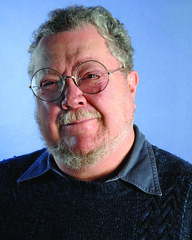 I too was saddened to learn of Dick Doty’s passing in a middle of the night e-mail from Karen Lee while I was traveling in Spain. I had first met Dick at one of the ANA shows about six or so years ago while inspecting the Smithsonian’s traveling exhibit. It was Karen Lee who introduced me to him. In the following years, I had seen them both when visiting the National Numismatic Collection. Like a number of curators I had met around the world, both Dick and Karen allowed me the privilege to hold in my hand from the Smithsonian’s vault many of the NMC’s rarities that regular visitors to the museum never get to see.
I too was saddened to learn of Dick Doty’s passing in a middle of the night e-mail from Karen Lee while I was traveling in Spain. I had first met Dick at one of the ANA shows about six or so years ago while inspecting the Smithsonian’s traveling exhibit. It was Karen Lee who introduced me to him. In the following years, I had seen them both when visiting the National Numismatic Collection. Like a number of curators I had met around the world, both Dick and Karen allowed me the privilege to hold in my hand from the Smithsonian’s vault many of the NMC’s rarities that regular visitors to the museum never get to see.
Because I was just in the mist of writing my forthcoming Numismatourist travel guidebook, I approached Dick if he would honor me by writing the book’s forward. For a such a book about numismatic museums, Dick was probably the best choice one could have. He agreed, but this was about 18 months ago.
When the book was finished earlier this year a little later than planned, I e-mailed Dick the manuscript, but by this time, he was undergoing treatments for lymphoma. He had felt that he might be able to write something but had other pressing concerns. I understood his situation but tried to be optimistic that he would be able to write something. Unfortunately his health deteriorated to the point where it would only be a matter of time as Karen would tell me. Around 2 a.m. of June 4 (Central European Time) I received the e-mail from Karen while in my hotel room on Spain’s Costa del Sol of the sad news.
Upon my return home, I put in a “Plan B” into effect. First, I typed out a dedication page, dedicating my book in the memory of Richard G. Doty, PhD. I felt this was best way for me to honor Dick’s memory, no longer being able to write the promised forward. Secondly, the task of writing the forward was now taken up by Karen, who had worked with Dick for many years at the Smithsonian. Both have been completed and forwarded to the publisher to be added to the book.
To read the earlier E-Sylum article, see: FURTHER READER REMARKS ON RICHARD G. DOTY (www.coinbooks.org/esylum_v16n25a08.html)
To read Mark Fox's obituary of Richard G. Doty, see: www.academia.edu/3738026/Richard_Doty_dies_at_age_71
GAR TRAVIS RETIRES FROM TELETRADE
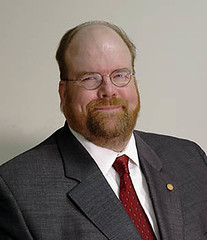 My final day as senior numismatist and chief cataloger for Teletrade numismatic auctions was on Thursday June 20th; I medically retired.
My final day as senior numismatist and chief cataloger for Teletrade numismatic auctions was on Thursday June 20th; I medically retired.
I had been with the company nine years and a month. While I am only 53 my health has begun to deteriorate, but rest assured to quote Monty Python; "I'm not dead yet." I have a few more years in which to enjoy life according to the oncologist and thanks to both the Federal Government through social security disability and the thoughtfulness of Spectrum Group International of which Teletrade is a division and their forethought to have a long term disability plan through their insurer and my 401k. My close friends joke had I done drugs or smoked or even womanized I would be fine, but cancer regardless is not choosy.
For 14 years prior to joining Teletrade I had the pleasure to serve a wide variety of clients through my business of numismatic consultancy; I will however refrain from numismatics upon my retirement and follow my passion of photography.
In the near future I expect to find myself in the eastern Sierras imaging rutting elk and then through the kindness of a close friend I will have the chance to photograph California condor in the wild and to top it all off in the coming year I hope to find myself in Banff, Alberta seeking a moose in the wild to grace my web site.
Yes, all along in my numismatic carrier in California I have had the pleasure to have a photography web site through the gracious generosity of John Nebel and Susie Nulty of Computer Systems Design Company of Boulder, Colorado. My friendship with both began in numismatics and now flourishes by sharing my images with the world - since 2005.
I sell nothing, just a place to view and I will add more to it as time permits. The site address is www.garphoto.com
Thank you for the newsletter; it is always a pleasure to see what is happening in the world of numismatics and to contribute insights when I can.
Gar adds:
This summer I celebrate my 25th year as an ANA member and dear Barbara Gregory will be receiving my medal for me at the ANA summer convention.
THE BOOK BAZARRE
MISSOURI CABINET OF HALF CENTS CATALOG AVAILABLE
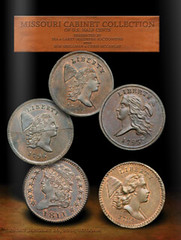 The magnificent Missouri Cabinet of half cents is now viewable in full color online from Goldberg Coins. This has got to be a numismatic historical record for an auction catalogue being completed and physically readable seven months or more in advance of auction just prior to the 2014 January Long Beach coin and collectibles expo.
The magnificent Missouri Cabinet of half cents is now viewable in full color online from Goldberg Coins. This has got to be a numismatic historical record for an auction catalogue being completed and physically readable seven months or more in advance of auction just prior to the 2014 January Long Beach coin and collectibles expo.
The plates are magnificent with every coin greatly enlarged and the many really important pieces having full page plates. The descriptions are highly detailed with the traditional McCawley-Grellman more conservative "EAC-standard" grades given in the text, often contrasting with the much higher PCGS slab grades, as much as 15 grading points difference in a few cases. And for this grading honesty, many collectors are thankful.
Extensive detailed pedigrees are given for each half cent.
The collection has been consigned by longtime half cent enthusiast "R. Tettenhorst" with whom Eric Newman was associated prior to retirement.

I noticed some interesting things while closely perusing the auction catalogue. It is supposed to be a complete variety collection of half cents but I noted a blatantly missing 2 star diebreak 1811 half cent.
Also noted was the presence of Fred "Freddy" Werner, a longtime and much-travelled Long Island coin dealer who passed away some years ago, in the pedigree lines of many of the best half cents in the collection, all ex-Willis DuPont to Werner.
We all know DuPont suffered a major home invasion which resulted in his coin collection including the Brasher doubloon and 1804 $ being stolen by organized crime figures and recovered by the FBI years later. Much of it reportedly buried in the ground.
I knew Fred Werner way back when he didn't have two pennies to rub together and visited his dilapidated Long Island home. This would have been in the mid 1960's.
So I wondered what connection Werner might have had with the recovery of the stolen DuPont coins and his apparent subsequent handling of the half cents. Does anyone have any more information on this? Logic would indicate "Freddy" became involved as a go-between and worked out an arrangement to handle at least some of the recovered coins - the half cents.
To view the complete catalog, see: http://issuu.com/goldbergcoins/docs/77small/1?e=1181641/3620382
DISCOVERING THE FINEST 1794 HALF CENT, HIGH RELIEF HEAD
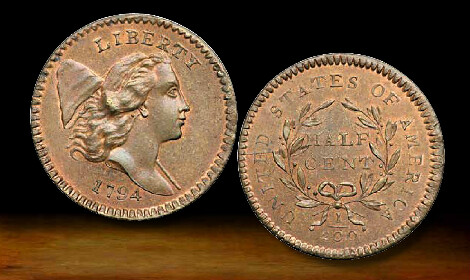
Alan V. Weinberg writes:
On the PCGS Coin Forum under the Missouri Cabinet blog, Fred Weinberg provides the fascinating story of his 1975 tiny Swiss village acquisition of the finest 1794 half cent (of any variety) ever discovered and now estimated at half a million dollars in the Tettenhorst sale.
Here's the story of how I came across that 1794 Half Cent, High Relief Head :
I started going to Europe in 1973, with Harry Gordon, who was the owner of Numismatics, Ltd., in Beverly Hills (I was almost 23 years old when I started there).
We would go to Europe every 5-6 weeks - London, Paris, Brussels, Zurich (and lots of other cities in Switzerland too) - buying US Gold coins in large quantities.
In early 1975, on one of our trips to Zurich, our contact and good friend there, Heiner Stuker, (a major Swiss coin dealer), told us about a small local coin show being held in a small town, about 1.5-2 hours outside of Zurich.
It was a Friday, I believe, and all three of us went to the show - a very very small town, in the middle of nowhere (but beautiful). The show was held in a Round building (yes, round! I had never seen a round building like this before), and when we walked in, there were small, simple tables with local dealers/vest pocket dealers showing their material in trays - I don't think there were more than one or two dealers that had showcases there - the coins were in diff. types of velvet trays for viewing.
At that point, all I had learned to say in Swiss Dueutch (Swiss German) was the phrase:
"Habben ze Americanisha Gold Munzen?" (Do you have any American Gold coins?)
I walked around asking that question, finding a few coins here and there, but nothing like we usually bought at the Banks in the Cities we frequented.
As I'm making my rounds (literally!!) I get to a table with an older gentleman and his wife; they didn't look like coin dealers, but more like farmers who had a small amount of European copper and silver coins on their trays - absolutely nothing special or rare, as far as I could tell.
I gave them my usual "Habben Ze Americanisha Gold Munzen?" question, and the man looked at me, and started to talk fast in Swiss German - which I really didn't understand much of....... I repeated "American Gold Munzen", and he hesitated for a second, turned around, and went into his folio (some type of briefcase behind the table), and pulled out two coins - a 1916 Standing Liberty Quarter in VF, and a 1794 Half Cent.
I remember this like it was yesterday - the round room was kinda dark, and there were no table lamps at his table - so, my very first look/glance at the coin, and I said to myself:
"That looks too good to be real - must be a restrike - wait, they didn't make any restrikes of 1794 half cents!" - all in 2 seconds, in my mind!
At 3 seconds, I knew it was real, and I asked "Vass iss da price?" (What is the price?)
He quoted me in Swiss Francs, which I calculated quickly as being about U.S. $1,200 or so.
I quickly paid him for both coins, found Harry and Heiner, and showed them the two pieces I bought. I told Heiner how wonderful the Half Cent was, and he went over to the table, and asked the man about the coins, and if he had more. He replied something to the effect that 'the copper coin has been in this village for a long time, passed down from family'.
The impression I got at the time was that someone from this village went to the United States in 1794/95, and brought back this lowest-denomination US coin as a souvenir of their visit - and it had been in this small town/village since that time!
At the show there, I didn't know it was a High Relief Head - I just thought that as a real nice 1794 Half Cent, it had to be worth $5k or more. I was so excited about this coin, that I didn't put it in our Brinks shipment of Gold, going back to Beverly Hills - I carried in in my briefcase home, as I didn't want it to get caught up in US customs at LAX, and be delayed for some reason.
Back at Numismatics, Ltd., I started researching the coin, and soon found out it was a "High Relief Head", and probably (at the time) the finest known of that variety. As the months went by, the value of the coin, in my head, went to $10K, $15k, etc. - till about 6 months later, when we printed up a very nice small brochure on the coin, and priced it at $35,000.......didn't sell it at the next 2-3 shows, and so about 2 months later, we entered into discussions with Julian Leidman, who had 'The' customer for it - and, if I remember correctly, we sold it to Julian for $30,000 (I might be off by a grand or two).
I have very fond memories of this coin - it was my first major rarity that I was responsible for figuring out what I had - the Die Variety, history, pricing, etc......and I thoroughly enjoyed all the time spent researching it......
That's the story of the 1794 High Relief Half Cent - hope you enjoyed it.
To read the complete article, see: forums.collectors.com/messageview.cfm?catid=26&threadid=891845&STARTPAGE=2
VIRGIL MCKNIGHT HANKS, JR.
Using Ancestry.com databases, Kay Olson Freeman found:
Virgil McKnight Hanks, Jr. (he was Jr. as father had same name) Born April 17, 1921, Decatur, Illinois. Died July 8, 1997, San Francisco. His wife was Laura Nadine Palmerton (born 1925, CA, lived Oregon - died Sept. 1985, San Francisco, CA)
David Lange writes:
One of the readers was inquiring about the late V. M. Hanks, who I knew as a fellow member of the Pacific Coast Numismatic Society when I lived in the San Francisco area.
Hanks was a very vocal individual. He held strong opinions on many matters both numismatic and otherwise. He was extremely proud of being a direct descendant of Nancy Hanks, Abraham Lincoln's mother, and he spoke of this often. His wife Nadine was a delightful person who also attended our meetings, though with less frequency, as she was not as interested in numismatics. In an odd coincidence, I'd known her years before meeting him, since she was my Junior year English teacher during high school.
To read the earlier E-Sylum article, see: QUERY: V. M. HANKS AND RICHARD NELSON INFORMATION SOUGHT (www.coinbooks.org/esylum_v16n25a13.html)
ORMSBY’S 1862 'HARVEST OF COUNTERFEITERS'
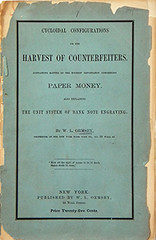 510 Ormsby, W.L. CYCLOIDAL CONFIGURATIONS OR THE HARVEST OF COUNTERFEITERS. CONTAINING MATTER OF THE HIGHEST IMPORTANCE CONCERNING PAPER MONEY. ALSO EXPLAINING THE UNIT SYSTEM OF BANK NOTE ENGRAVING. New York: Published by W.L. Ormsby, 50 Wall Street, c. 1862. 8vo, original printed wraps. 45, (3) pages; 3 slips of paper tipped in on page 26 depicting methods of transferring “exactly coinciding impression(s)… by ‘offset’ alone.” Front wrap and first and last few leaves loose and chipped at outer edges; lacking rear wrapper; signatures loose. Good. (1250.00)
510 Ormsby, W.L. CYCLOIDAL CONFIGURATIONS OR THE HARVEST OF COUNTERFEITERS. CONTAINING MATTER OF THE HIGHEST IMPORTANCE CONCERNING PAPER MONEY. ALSO EXPLAINING THE UNIT SYSTEM OF BANK NOTE ENGRAVING. New York: Published by W.L. Ormsby, 50 Wall Street, c. 1862. 8vo, original printed wraps. 45, (3) pages; 3 slips of paper tipped in on page 26 depicting methods of transferring “exactly coinciding impression(s)… by ‘offset’ alone.” Front wrap and first and last few leaves loose and chipped at outer edges; lacking rear wrapper; signatures loose. Good. (1250.00)
Extremely rare; only the third example, to our knowledge, to come to sale in at least the past thirty-five years. Bitter at not having secured the contract to print Treasury Notes, Ormsby’s screed mercilessly attacks the American Bank Note Company and, to a lesser extent, the National Bank Note Company, whose managers he claims “have but one object in view, viz. to make money.”
He concludes that “In the consolidation of the American system of Note engraving the ‘configuration’ is completed; and in every deceptive compound-cycloidal-loop that has formed it, from the days of Perkins’s ‘stereotype plate’ to those of the ‘Patent Green Tint,’ a Bank Superintendent or other Officer has been inclosed, forming a ‘portrait gallery’ of distinguished—patrons… Within this perfect cycloidal configuration, the counterfeiters are about to hold a jubilee—to reap a harvest. One hundred and fifty millions of United States Treasury Notes—engraved in ‘ten days,’ by patching together material previously used for inferior purposes, and printed in three colors, one on the top of another, making confusion worse confounded, at as much expense as possible—signatures engraved—a legal tender in payment of all debts—as good as gold in thirty-two states, and almost as good throughout the world.—One hundred and fifty millions—all alike—each one of which is destined to wander, without a military escort, through Camps—Cottages—Farms—Banks—Tents—Ranches and Wigwams, until it becomes as ragged, torn, defaced, and soiled as a ‘three years’ traveller in the Arctic regions without supplies.—One hundred and fifty millions of them, destined to be counterfeited in the North all the way to Kamskatka; in the South, to Patagonia; in the West, to China; and in the East, to Jerusalem.”
Sigler 1961. Not in the Fuld Library sales, McKerchar or the Dictionary Catalogue of the Library of the American Numismatic Society. Apparently, John J. Ford's copy, though not marked as such.
For more information on the sale, see: www.numislit.com
THE BOOK BAZARRE
JEFF SHEVLIN JOINS NORTHWEST TERRITORIAL MINT
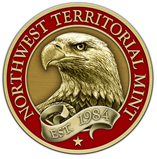 Northwest Territorial Mint has named Jeff Shevlin director of special projects, charging him with oversight of projects related to branding the mint’s top-of-the line art medals, digitizing assets, and accelerating numerous publishing and web objectives from its mint in Dayton, Nevada.
Northwest Territorial Mint has named Jeff Shevlin director of special projects, charging him with oversight of projects related to branding the mint’s top-of-the line art medals, digitizing assets, and accelerating numerous publishing and web objectives from its mint in Dayton, Nevada.
Northwest Territorial Mint and its subsidiary companies Medallic Art Company and Graco Industries have produced some of America’s most important minted items through the course of their 110-year heritage. These include special medals and hundreds of related collectable items for collectors and dealers, including the Peabody Award, the Pulitzer Prize, and the Medal of Honor.
Ross Hansen, founder and CEO, said, “We are elated to have Jeff join our team. He is a nationally recognized numismatist who brings strong technical skill and leadership talent to our organization.”
“I look forward to working with Northwest Territorial Mint’s master artisans to help provide the finest quality medals and grow the company’s role in the great numismatic community,” Shevlin said.
Shevlin is the former executive director of the American Numismatic Association and brings his background in information technology and managing large organizations to the world’s largest private mint. He can be reached directly at Jeff.Shevlin@NWTMint.com.
About Northwest Territorial Mint:
Since 1984, Northwest Territorial Mint has specialized in designing and creating custom coins, medallions, and related items of the highest craftsmanship for individuals and institutions worldwide, and has grown to include a family of prestigious mints. Most notable of these is Medallic Art Company, founded in 1903.
Northwest Territorial Mint mints coins, medals, and medallions for governmental, corporate, and private entities around the world. Northwest Territorial Mint is the primary supplier of official U.S. military medals, including the Medal of Honor. Coins and medallions minted by Northwest Territorial Mint are awarded at all levels of the U.S. government and in private organizations such as the Boy Scouts of America, the Girl Scouts, the National Rifle Association, and the International Association of Fire fighters, as well as hundreds more private and foreign governmental entities.
The retail showroom is located in Federal Way, Washington, where Northwest Territorial Mint also conducts its precious metals bullion business. As a major dealer in precious metal bullion products in the U.S. and Canada, Northwest Territorial Mint is internationally recognized and well-established in both wholesale and retail supply of silver, gold, palladium and platinum precious metal bullion.
As a trusted retailer of United States Mint bullion, Northwest Territorial Mint buys and sells American Eagle gold bullion, silver bullion, and platinum bullion coins. Northwest Territorial Mint also buys and sells Canadian Maple Leaf gold bullion, silver bullion, palladium bullion and platinum bullion coins, as well as selected other bullion coins. Northwest Territorial Mint also sells investment-grade rare coins and builds portfolios for investors who wish to add bullion and rare coins to their assets.
The company is the exclusive mint of Pan American Silver Corp. silver bullion, as well as Northwest Territorial Mint branded silver bullion, Stagecoach “divisible” silver bullion, and the company’s newest bullion product, Silver Bullet Bullion™, real silver shaped like America’s favorite ammunition.
Northwest Territorial Mint has facilities located in Dayton, NV; Federal Way, WA; Auburn, WA; Green Bay, WI; Tomball, TX; Alexandria, VA; and the Pentagon.
For more information about Northwest Territorial Mint, visit www.NWTMint.com .
DICK JOHNSON ON JEFF SHEVLIN'S APPOINTMENT
I am delighted to learn that Jeff Shevlin has been snapped up by Medallic Art Company / Northwest Territorial Mint after leaving the American Numismatic Association. in Colorado Springs.
Jeff is slated to take the same title and position -- Director of Special Projects --that was the same as my previous associate at Medallic Art, Rob Vugteveen. Already Jeff has been assigned the corner office at the Dayton Nevada plant that once was that of Rob's. I reported to Rob before he left for a major project in Nevada.. I hope now to have to report to Jeff.
Jeff has been assigned the highest priority to assist me on the work of the History of Medallic Art Company. I have been at work on this project for more than six months and am about 20% into this multi-year effort. I foresee with Jeff 's help -- an established author and publisher of a book on medals -- will make the chore go much faster to reach completion.
Jeff wrote and published that book on medals, Discover the World of Charbneau So-Called Dollars, with co-author William D. Hyder. They asked me to write the preface of that book, which explores the little known medals issued at the 1939-40 Golden Gate International Exposition.. I was glad to do that.
Two years ago the two authors, Jeff and Bill, visited the Medallic Art plant in Dayton. What a prophetic event that turned out, for Jeff to return at this time now as an employee. The guide for that visit was Rob Vugteveen. Bill Hyder wrote an article of that visit and illustrated it with a number of photos.
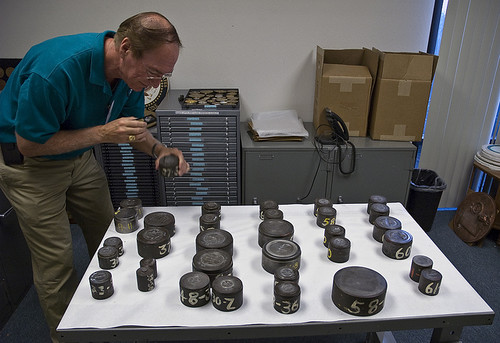
Rob had set out 17 sets of dies -- predominantly those of so-called dollars -- for Jeff to examine.
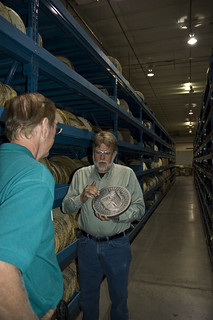
Here Rob and Jeff are in the company die vault where Rob is holding an oversize pattern, a copper galvano, for Jeff's examination.
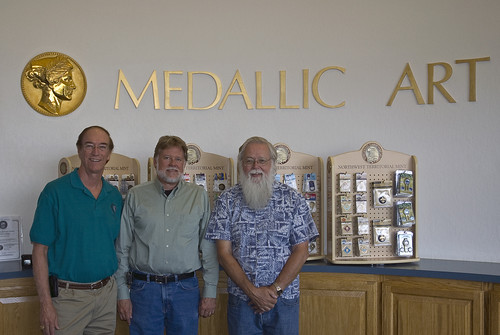
The three of them, let to right, Jeff Shevlin, Rob Vugteveen, Bill Hyder.
If you wish to read Bill's article go to: coinpeople.com/index.php?topic/31047 . Welcome aboard Jeff. I am looking forward to working with you.
QUERY: HOW DO YOU MAKE AN ELECTROTYPE?
When I was younger I collected ancient Greek and Roman coins. I am getting older now and have to sell them as I don't have any children. I hate to part with them and one day I thought if I could make electrotypes of them I could keep the electrotypes and enjoy them and put the valuable originals in auction. To that end I started trying to figure out how to make them.
I have had some success but find there are so many variables to contend with!
I read what I could find on line but everything was too general. I read Ken Bressett's article and talked to him when I went down to Colorado Springs but he hasn't tried to make them and so the details are missing. By the way, Ken also collects ancients.
I used to work at Carnegie Museum in Pittsburgh in Vertebrate Paleontology so I know how to make molds. I tried wax and sylastic rubber and have had better luck with the rubber molds. I tried using graphite powder (from a lead pencil)--that didn't work, bronze conductive paint (obscured the detail and pulled away from the mold because it is mixed in an acrylic medium) and graphite in a colloidal suspension. The graphite worked the best but the plating isn't perfect. Sometimes there are rough areas (perhaps from a trapped air bubble?).
So I am slowly trying to solve this puzzle but there are so many variables. Could your readers be so kind to give me some advice?
1. I like the idea of using a bronze powder for coating the mold. Where can I buy the best quality?
2. Has the monograph on electrotypes mentioned in your article been published? If so, where can I get a copy?
To read earlier E-Sylum articles, see:
ON ELECTROTYPES
(www.coinbooks.org/esylum_v09n43a14.html)
PISTRUCCI WATERLOO MEDAL ELECTROTYPES
(www.coinbooks.org/esylum_v11n35a16.html)
DICK JOHNSON ON ELECTROTYPES
(coinbooks.org/esylum_v11n36a17.html)
DICK JOHNSON ON ELECTROTYPING IN AMERICA
(www.coinbooks.org/esylum_v13n31a16.html)
When I was working at the museum I used to go to the library on Saturdays and just go through the stacks and pull out books that looked interesting. I had collected U.S. coins when I was younger but had lost interest in them.
One day I found a book that had photos of ancient coins and they looked interesting to me. I went to Bill Woodside who was the business manager and also ran the coin room. I asked him how do I learn about ancients and he told me to come in Saturday. He had me sit down at a table and he pulled out quite a few late Roman bronzes and a large pile of books. He said "identify them". I told him I didn't read Latin and he said "you'll learn" and walked out of the room.
I started going in every Saturday and that is how I met Glenn Mooney. One day Glenn came in with some ancient coins that he had bought in Wilkinsburg. I asked him if there were any more and he said no. I thought I had better check it out. I went to the store and bought a lovely Greek bronze from Syracuse for $3.00. While looking at one of the trays I noticed a lump in one corner and so picked up the felt and there was a Greek silver coin from the Thessalian Confederacy. I was excited and bought it for $10.00. I still have both coins.
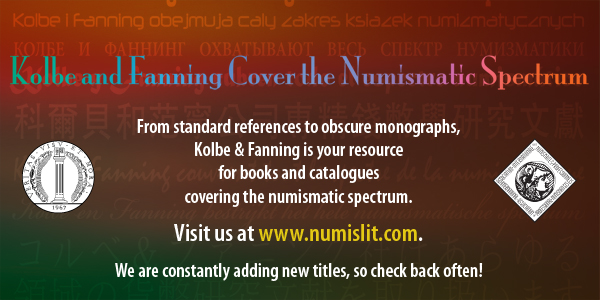
MORE ON MAP MEDALS
Alan V. Weinberg writes:
Regarding the Tony Lopez segment on his newly acquired Mercator medal - it is mid 20th-century-made, scarce but available in its original blue case of issue in England. I've owned two. They are well made silver cast or electrotype plates joined back to back. I can't seem to recall who made them but memory seems to indicate a prominent numismatic firm like Spink or Baldwin some decades ago.
I distinctly remember to this day perhaps 45 years ago when a top left hand page article in either Coin World or Numismatic News pictured and announced the auction of a genuine old Mercator medal that sold for $50,000. I cannot remember where the sale took place or the buyer but something tells me it was a major institution, if my memory serves.
Dave Hirt writes:
I read with interest the submission on the Drake Map Medal. It reminded me that I have a catalog where one was sold. Could this one have been an original?
It was in the Charles T. Jeffery collection, sold 6/15/1936 by Philadelphia auction house Samuel T Freeman. I am not at home to consult my catalog, but my computer comments state, "This almost unknown sale contained rather amazing material!"
Perhaps one of our readers who has this catalog would comment on the Drake lot description.
Byron Weston writes:
The Drake Mercator Map Medal discussion reminded me of an early 19th Century Map medal I also acquired from the UK. I don't have my notes on this at hand but know this is unlisted in copper by Rulau....
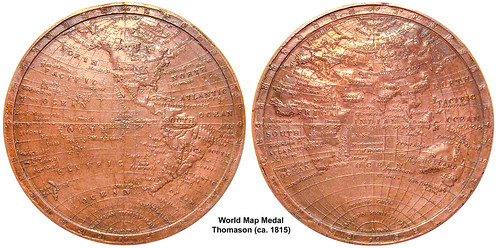
To read the complete article, see: MORE ON THE DRAKE MERCATOR MAP MEDAL (www.coinbooks.org/esylum_v16n25a17.html)
QUERY: DORR & BREWSTER INFORMATION STILL SOUGHT
Tom Rigney writes:
For some time now I have been meaning to request assistance in finding information regarding a note I purchased a few years back. I'll attach a photo. It's an 1817 .25 Detroit Michigan note, signed by Dorr & Brewster and is one of the earliest notes of record from this area. I have had minimal success in researching Melvin Dorr & Brewster and thought this might be an interesting piece to request the help of some of the better research members.
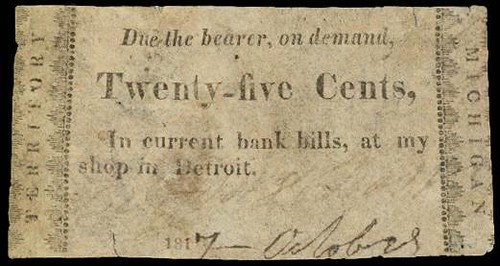
To read the earlier E-Sylum article, see: QUERY: DETROIT DORR & BREWSTER INFORMATION SOUGHT (www.coinbooks.org/esylum_v16n17a17.html)
TOKENS OF WILLIAM BATEMAN OF WARRNAMBOOL, AUSTRALIA
Darren Burgess, President, Numismatic Association of Victoria writes:
Thanks for yet another fantastic issue of the E-Sylum. I thought readers would be interested to know that there's a tenuous numismatic link to the article entitled AN AUSTRALIAN MAN'S SHOCKING STATIC JACKET in the last edition of The E-Sylum.
Warrnambool was the place of issue of two Australian Tradesmen's Tokens in the mid 1800s. William Wilson Jamieson and William Bateman Junior & Co were the issuers. It's interesting to note that William Bateman Junior & Co had a suspicious fire in 1856, the year after his tokens are dated. Most of the tokens today are found in a discolored and pitted state and it is assumed that this was as a result of some of them being caught in the fire. It's worth noting that there's no evidence to suggest that explosive clothing was the cause.
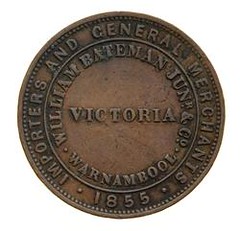 The business was run under the name of William Bateman, Junior and Co., although William Senior was also active in the business. Bateman and Co. operated from their premises in Banyan Street with stores at the jetty. Their business was located in Banyan Street, and they carried a wide range of goods, including hardware, drapery, machinery and groceries. 'They also had a large portfolio of crop financing and other loan advances.' (Turnbull, 1992, p.35)
The business was run under the name of William Bateman, Junior and Co., although William Senior was also active in the business. Bateman and Co. operated from their premises in Banyan Street with stores at the jetty. Their business was located in Banyan Street, and they carried a wide range of goods, including hardware, drapery, machinery and groceries. 'They also had a large portfolio of crop financing and other loan advances.' (Turnbull, 1992, p.35)
The business was prosperous, and by 1855 it was one of the leading businesses in the district. William Junior Invested almost the entire profits of the business in land speculation, which was rife in the Western District at that time, and ran the business on credit from the banks. According to Turnbull at the end of 1854 'the company's overdraft was £84,200. The following year it was £100,855.' (Turnbull, 1992, p.36)
This was not a sound policy, as many of those receiving the loans from Bateman were unable to meet their debts to him.
Under a cloud of suspicion Bateman & Co.'s businesses were closed on 26 September 1856, leading to the closure of ten other businesses in Warrnambool (Turnbull 1992, p. 35). Bateman appeared in court in Melbourne to face charges brought against him by the Banks of Victoria and Australasia.
After an initial hearing, Bateman returned to Warrnambool to collect additional papers relating to the case. The night before he was to return to Melbourne, the morning of November 4, the business burnt to the ground. Bateman & Co.'s premises, and merchandise to the value of £30,000 was consumed by the blaze. The Warrnambool Examiner of 7 November 1856 carried both a front page story on the fire itself, and a report on the inquest held on 6 November.
The story was presented as 'one of the most fearful visitations which has ever befallen this Town and District', and drew the reader's attention to the bravery of the locals who assisted to raise the alarm and remove goods such as draperies, and gun powder of which 'about 20 barrels were carted away, which had they exploded, would have blown down most of the houses,' (Warrnambool Examiner, 7 November 1856, p.1). The Examiner also noted that 'All the account books are saved. The iron safes (two very superior ones, we believe) can now be seen through the flames'.
To read the complete article, see: William Bateman Junior & Co, Importers & General Merchants, Warrnambool, Victoria (museumvictoria.com.au/collections/themes/2569/william-bateman-junior-co-importers-general-merchants-warrnambool-victoria)
To read the earlier E-Sylum article, see: AN AUSTRALIAN MAN'S SHOCKING STATIC JACKET (www.coinbooks.org/esylum_v16n25a26.html)
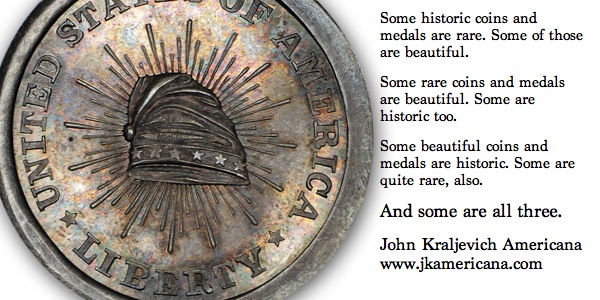
LONDON COUNTERFEITERS PAINTED FAKE LEAD COINS
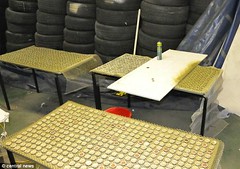 A gang made £1 and £2 coins from lead and sprayed them with silver and gold paint, a court heard.
A gang made £1 and £2 coins from lead and sprayed them with silver and gold paint, a court heard.
Mark French, 47, Tony Rees, 50, and Anthony Dunn, 53, bought ingots of metal to put through their own press in an east London factory.
Coins worth £10,355 were recovered and the gang processed enough metal to make £16,000 worth of counterfeit currency in a month.
Police had been keeping the men under observation and raided two premises - a rented business unit in Tarling Road, Canning Town, and a house in nearby Hoy Street.
The business unit was disguised as a vehicle recovery garage as the men worked inside making thousands of coins, the Old Bailey heard.
Royal Mint experts examined the buckets of coins and found they were crude copies.
The coins would not have been accepted in a vending machine because they were magnetic and the wrong size.
'There were around five to eight thousand in various stages of production when officers executed a warrant at the premises.
‘It was quite a labour intensive process. Each moulded coin had to have a penny placed in the centre before it was sprayed gold and then each was finished by hand to make them appear more genuine.’
To read the complete article, see: Gang made £16,000 of fake £1 and £2 metal coins in just one month by painting lead with silver and gold PAINT (www.dailymail.co.uk/news/article-2345748/Gang-16-000-fake-1-2-metal-coins-just-month-painting-lead-silver-gold-PAINT.html)
THE MUSEUM OF MILETUS, TURKEY
 There’s a classic excursion that everyone who has stayed in Kusadasi does – it ticks off the three most attractive nearby ruins: Priene, Miletus and Didyma. We didn’t want to take the classic tourist approach, however, and decided instead to split up the day, with one excursion to Miletus and Didyma, and the second to Priene.
There’s a classic excursion that everyone who has stayed in Kusadasi does – it ticks off the three most attractive nearby ruins: Priene, Miletus and Didyma. We didn’t want to take the classic tourist approach, however, and decided instead to split up the day, with one excursion to Miletus and Didyma, and the second to Priene.
We didn’t take the sacred road from Didyma to Miletus, even though it’s been well excavated and reconstructed in recent decades. We used the normal road, which meant that on our way, we passed the newly established museum in which the discoveries from Miletus, its surrounding area and Didyma are on display.
Where today, you park your car in the middle of a flood plain, there was nothing but sea 3,000 years ago. Miletus lay on a spur of land on which archaeologists have found almost as many Bronze Age strata as in Troy. Around 1100, the city was then destroyed so that Ionic colonists – according to legend – could found the city anew in the year 1053 BC. The myth says that a son of the last King of Athens led the settlers there, which led to attempts to explain the close alliance between the two cities.

Miletus. Stater. Gorny & Mosch 190 (2010), 261.
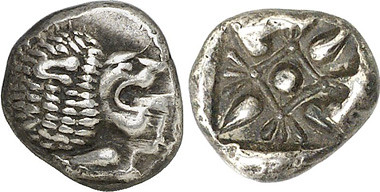
Miletus 1/12 stater. Gorny & Mosch 200 (2011), 1818.
The museum of Miletus is truly worth a visit. It provides an excellent overview on the history of the city. Of particular note was a statue of the Meander river god.
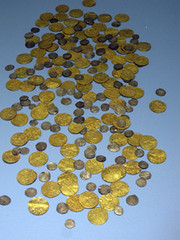 Finds from the sacred way are also on display in the new museum. Among them is the hoard discovery of Söke Tekkisla, which came to the Museum of Miletus in 1996. It consists of 125 Ottoman gold coins, minted almost exclusively under Suleiman I, and 174 contemporaneous Venetian coins. There are also 676 Ottoman silver coins.
Finds from the sacred way are also on display in the new museum. Among them is the hoard discovery of Söke Tekkisla, which came to the Museum of Miletus in 1996. It consists of 125 Ottoman gold coins, minted almost exclusively under Suleiman I, and 174 contemporaneous Venetian coins. There are also 676 Ottoman silver coins.
To read the complete article, see:
Springtime in Turkey – Part 8
(www.coinsweekly.com/en/News/4?&id=2085)
ON THAT OLD BOOK SMELL
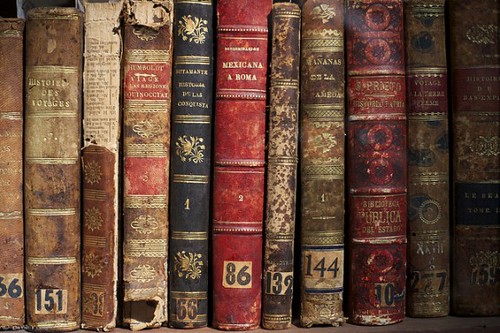
Smell is chemistry, and the chemistry of old books gives your cherished tomes their scent. As a book ages, the chemical compounds used—the glue, the paper, the ink–begin to break down. And, as they do, they release volatile compounds—the source of the smell. A common smell of old books, says the International League for Antiquarian Booksellers, is a hint of vanilla: “Lignin, which is present in all wood-based paper, is closely related to vanillin. As it breaks down, the lignin grants old books that faint vanilla scent.”
A study in 2009 looked into the smell of old books, finding that the complex scent was a mix of “hundreds of so-called volatile organic compounds (VOCs) released into the air from the paper,” says the Telegraph. Here’s how Matija Strlic, the lead scientist behind that study, described the smell of an old book:
A combination of grassy notes with a tang of acids and a hint of vanilla over an underlying mustiness, this unmistakable smell is as much a part of the book as its contents.
To read the complete article, see: That “Old Book Smell” Is a Mix of Grass and Vanilla (blogs.smithsonianmag.com/smartnews/2013/06/that-old-book-smell-is-a-mix-of-grass-and-vanilla/)
JOHN J. FORD'S HOTEL HALLWAY PREDICAMENT
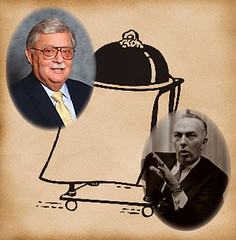 This story is about an adventure John Ford had while attending an American Numismatic Association convention in New England. Like all summer shows, the ANA annual convention was usually during the hottest part of the summer. Few of the sleeping rooms had air conditioning and it was rare in the early 1960s that the bourse floor was adequately cooled.
This story is about an adventure John Ford had while attending an American Numismatic Association convention in New England. Like all summer shows, the ANA annual convention was usually during the hottest part of the summer. Few of the sleeping rooms had air conditioning and it was rare in the early 1960s that the bourse floor was adequately cooled.
John usually got a two-bedroom suite on a high floor with a living room and usually shared the cost with a collector. In this instance he was sharing with Emanuel (Manny) Taylor. John always ate his dinner in the suite so he could put on a pair of short and a T-shirt and open all the windows and spend the evening discussing numismatics with his “guest.” On this particular evening the two men looked at the room service menu and John, in his typical fashion, ordered several courses, wrote out exactly what he wanted and exactly how he wanted it prepared as well as four bottles of beer. At the time, Manny was trying to lose weight so he ordered food sparingly and only iced tea to drink.
As they waited for dinner they started to discuss early silver dollars of which Manny had during the previous decade assembled an exception set. They analyzed rarity and variety, fought about die states and errors in Bolender’s descriptions, and thus began an evening of discussion. About 30 minutes into the conversation, room service was at the door and the waiter pushed the table tray down the small hallway into the room. John and Manny sat down to eat, continuing their heated discussion.
Because of the heat, when dinner was complete they both felt that they should call room service to remove the used trays and dishes. When the waiter did not appear in 30 minutes John got worked up and said, “Manny let’s get this stuff out of here, it smells!” John tried to push it out himself and when that didn’t work he told Manny to push while he pulled. John got to the door, opened it and started to pull the table out into the hallway. However, the table got caught on the doorknob, leaving John in his shorts trying without success to pull it free. Seeing John struggling in the hallway caused Manny to laugh like crazy, which did not please John. “You dope,” he said. “Pull the table back in the room.” But Manny was laughing too hard to do anything.
All of a sudden down the hall, the elevator doors opened and out came four of the wives of ANA officials. They were headed John’s way and he yelled, “there are ladies coming, pull the tray back inside.” But Manny was now laughing even harder and still could not help. John’s modesty overcame him; he moved back a little way into the hall, took two giant steps and tried to jump over the table into the room. Instead, he landed square in the middle of the dirty dishes and food still on the tray, and then slid off the other side into Manny, who was now on the floor laughing uncontrollably.
“Do you think the ladies saw me?” John asked.
To read the complete article, see: Remember When: John J. Ford Becomes Airborne (stacksbowers.com/Blogs/remember-when-john-j-ford-becomes.html)
FEATURED WEB PAGE: ANS MAGAZINE
This week's Featured Web Page is the ANS Magazine, suggested by Ray Williams.
ANS Magazine is published four times per year by the American Numismatic Society, the nation's preeminent institution devoted to the appreciation and study of coins from all periods and countries. The magazine is sent to ANS members, and articles appear on this website after publication of the print edition.
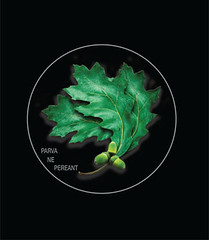
http://ansmagazine.com/
